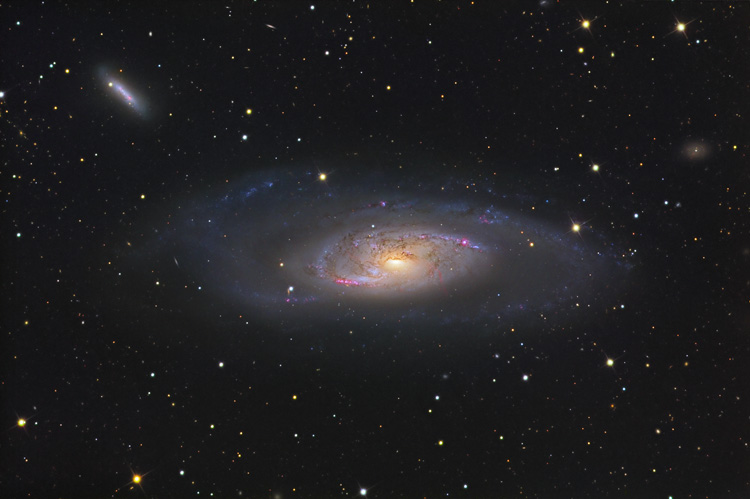
Clic here for 70% size 2797x1863 (820 kB)
The bright Sb spiral galaxy Messier 106 (NGC 4258) is about 23 to 24 million light years distant, receding at 537 km/sec.
16" cassegrain in secondary focus at f/10
About this Image
As its equatorial plane is similarly inclined to the line of sight, many features like distinct dust lanes and red emission areas resemble what we know from the Andromeda galaxy M31.
They form a spiral pattern which can be traced well into its bright central region to the core. The spiral arms apparently end in bright blue knots.
These knots are most probably young star clusters which are dominated by their very hot, brightest and most massive stars;
The occurance of these hot stars indictes that these clusters cannot be very old, these show us the regions of very recent star formation.
Mysterious bended red glowing streamers of ionized Hydrogen are pointing out from the center, revealing differently oriented superimposed spral arms.
Find a wider image of this area here.
Find an article on the active nucleus here: 1.
Find a combined visible/X-ray/radio image of M 106 showing the anomalous spiral arms here: 2.
Technical Details
Optics
Mount
MK-100 GEM
Camera
SBIG STL-11000M at -20C, 8-pos filter wheel
Filters
Baader LRGB + H-alpha
Date
Apr-May 2009.
Location
Wildon/Austria
Sky Conditions
mag 5 sky, raw FWHM 1.8-2.5", temperature 10-15 C
Exposure
L:Ha:R:G:B = 420:120:120:120:120 minutes
(20 minute sub-exposures for LRGB, 60 min for H-alpha),
Programs used
Maxim DL 4.5;
CCDStack
Fitsliberator
Photoshop CS3
North is to the bottom-left side;